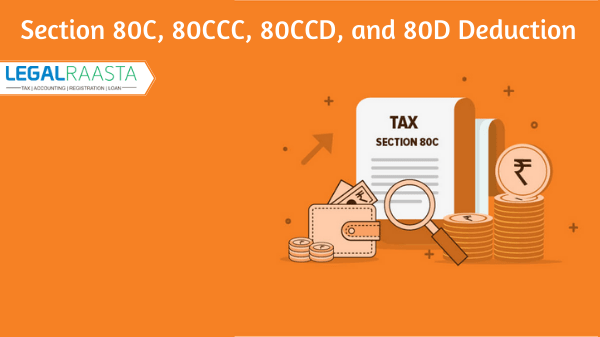You will reduce your taxable profits by using Parts 80C, 80CCC, and 80CCD deduction. Every fiscal year, we look for ways to reduce the amount of money we pay in taxes when we file them. But first, learn about the tax deductions available to you as a taxpayer under section 80C, 80CCC, and 80CCD.
As Indian taxpayers, we are all searching for ways to save money and reduce our tax deductions. The benefit of seeking tax deductions under section 80C, 80CCC, and 80CCD is that your taxable income and tax liability will be reduced. The majority of us have a general understanding of how to save taxes, but we always fail to do so.
The most well-known tax-saving choice for taxpayers is Section 80C of the Income Tax Act. However, in the pursuit of providing the best possible public facilities, there are times when the tax imposed is unfair, depriving people of discretionary income to spend on personal and recreational activities.
Recognizing this paradox, lawmakers created provisions in the Income Tax Act that enable a taxpayer to assert deductions (reduce taxable income) under different parts. The Central Government, on the other hand, has made arrangements for more than one of these parts to support commoners.
According to Income Tax India, here is a fast guide to the various types of taxes in India that will help you prepare your taxes for this fiscal year.
What is the concept of a tax deduction?
Contents
It is a tax deduction that lowers taxable income and thereby reduces a person’s tax liability.
Income tax is an essential source of revenue for the government, and it is also true that a large portion of an individual’s salary or earnings may fall into the x tax bracket.
The parts of the Income Tax Act of 1961 ensure that the taxable income slab is reduced.
Under Section 80C –
One can claim exemption from the full tax debt of Rs. 1.5 Lakh by doing certain investments under Section 80 C. However, note that only a qualified mentor, i.e., a person or HUF may seek exemption under this section. While the maximum output is allowed to be limited to Rs. 1.5 Lakh, there is no minimum limit. The funds to be deducted under Section 80 C are Public Provident Fund (PPF), Equity Linked Savings Scheme (ELSS), National Pension Scheme (NPS), National Savings Certificate (NSC), Fixed Deposit (FD) ), Unit Linked Insurance Plan (ULIP)), Sukanya Samriddhi Yojana (SSY), and the Elderly Care Scheme (SCSS). Other costs or investments eligible under Section 80C include the principal amount of home loan repayment, stamp duty or transfer of property, and tuition fees for any accredited school, college, a university with only two children.
The investments that qualify for deductions under 80C are listed below:
| Investment | Description |
| Employee Provident Fund (EPF) | Employer and employee contribute an equivalent amount (12% of basic) to the fund that performances as a retirement profits scheme. |
| PPF Funds | A long-term investment choice given by the Government of India. |
| Health Insurance Premiums | Premiums paid to a health insurance plan—person or a family floater plan. |
| Equity Linked Savings Scheme (ELSS) | It is an open-ended mutual fund that invests most importantly into equities for advanced returns and gives tax advanatges as well. |
| NSC Certificate | A safe savings scheme given by the postal department. |
| Life Insurance Premiums | Premiums paid for a life insurance plan in a fiscal year |
| Children’s Tuition charge | Tuition charges for full education to any college/university located in India. Permissible up to two children. |
| Housing | Repayment of home loan principal and expenses sustained on registration and stamp duty |
| Post Office Fixed Deposit | Same to a bank fixed deposit but only the 5-year deposit be suitable for deductions. |
| Infrastructure Bonds | These are government-accepted infra bonds. Allotted by businesses such as India Infrastructure Finance Company and Infrastructure Development Finance Company |
Under section 80 CCC –
Under this category, a person may receive deductions of up to Rs. 1.5 Lakh of money paid for a LIC annuity plan or other insurance company.
Please note that the amount paid for the annual grant, including interest earned is taxable in the year of acquisition.
Under section CCD –
The National Pension Scheme or NPS is one of the most popular tax-saving tools that any citizen between the ages of 18 and 65 can join for tax benefits. Please note that the only condition is that a person must comply with KYC procedures.
Here is the eligibility for tax benefits in the NPS in 3 categories:
1. Section 80CCD (1) – Employee contribution of up to 10% of basic salary and charity (DA) up to ₹ 1.5 lakh is eligible.
2. Section 80CCD (2) – Employer contribution of up to 10% of basic + DA is eligible. Remember that the employer’s contribution is an additional deduction.
3. Section 80CCD (1B) – The only category where additional disbursements reach Rs. 50,000 in the NPS is eligible.
It should be noted that the additional tax advantage of Rs. 50,000 is more than the profit of Rs. 1.5 Lakh demanded under all other fees.
Under section 80D –
Under section 80D, the premium paid for by the health insurance policy is tax deductible. The observer is eligible to withdraw Rs. 25,000 under Section 80D for your insurance, spouse, and dependent children. If the thinker is over 60 years old, this deduction is available up to a maximum of Rs. 50,000. Note that additional reductions in parental insurance up to Rs. 25,000 are also allowed. In this case, the parents are over 60 years of age, and the available reduction is ₹ 50,000. Also note that if both observers and parents (parents) are 60 years of age or older, the maximum exit available is Rs. 1 Lakh.
Section 80CCF
This section allows for tax deductions on the purchase of particular long-term infrastructure bonds that have been approved by the government. Individuals and Hindu Undivided Families were both liable for a 20,000 INR deduction. From A.Y., the benefits under this clause have been phased out. The Income Tax Act’s Section 80CCF is a special provision that provides tax benefits to investors in such schemes. It was proposed in the 2010 budget and went into effect in 2011 as part of the 2011 Income Tax Act. This section offers benefits to investors in infrastructure and other bonds by enabling them to subtract their investments from their income, allowing them to save money that would otherwise be taxed.
Section 80CCG
Individuals are entitled to tax deductions of up to 50% of the invested sum, with a maximum deduction of INR 25,000 for three consecutive Assessment Years, under this clause. Section 80CCG, also known as the Rajiv Gandhi Equity Savings Scheme, offers tax benefits to those who invest in the stock market.
Individual savings boost as a result, as does India’s domestic capital market. Tax deductions apply to taxpayers who invest in the country’s stock market under Section 80CCG of the Income Tax Act.
This segment was recently introduced to enable people to invest in equities by giving first-time buyers tax incentive for purchase.
Section 80U
This segment seeks to offer tax benefits to people who are physically disabled. A visually disabled person who is blind or mentally retarded is eligible for tax deductions of up to INR 75,000, which was raised from INR 50,000 to INR 75,000 in FY 2015–16. From FY 2015 to 16, the overall amount that can be deducted for extreme impairment has been increased from INR 1,00,000 to INR 1,25,000. Physical disorders such as autism, cerebral palsy, and others are listed as extreme disabilities.
Section 80TTA – Interest on Savings Account
Deductions on Gross Total Income Interest on a Savings Bank Account. If you are an individual or a HUF, you can apply for a reduction of a maximum of Rs 10,000 in interest income from your savings account with a bank, cooperative community, or post office. Add interest from savings bank account to other income. Section 80TTA deductions are not deducted from interest income from random deposits, recurring deposits, or interest income from corporate bonds. Section 80TTA deductions are not deducted from interest income from random deposits, recurring deposits, or interest income from corporate bonds.
Section 80TTA provides for a deduction of Rs 10,000 from income interest. These reductions are available on an individual basis and at HUF.
This catch is allowed for interest earned –
- From a savings account with a bank
- From a savings account and a cooperative community that runs a banking business
- From a savings account at the post office
Section 80GG
The HRA usually becomes part of your salary and you can apply for an HRA reduction. If you do not receive an HRA from your employer and pay rent for any furnished or unoccupied living quarters of your residence, you can apply for a deduction under section 80GG in respect of the rent you pay. Here are a few conditions that must be met –
- Self-employed or earning
- You have not received an HRA at any time during the year claiming that the 80GG HRA should not be part of your 80GG claim salary.
- You or your spouse or young child or HUF member – you do not have a place to live where you currently live, do office work, or hire or run a business or profession.
- In the event that you are the owner of residential property in any area, where your Property Rates are calculated under applicable categories (such as the property you are moving to), no deduction under section 80GG is permitted.
Section 80DD
Rehabilitation of the Faithful Disabled Relative Rehabilitation
Section 80DD deductions are available from the resident or HUF and are available at:
a. Expenses incurred in treatment (including nursing), training and rehabilitation of a disabled relative
b. Payment or deposit of a specified scheme for the care of a disabled relative.
i. Where the disability is 40% or more but less than 80% – a fixed deduction of Rs 75,000.
ii. Where there is a serious disability (80% or more disability) – a fixed deduction of Rs 1,25,000.
To claim this deduction a certificate of disability is required from designated medical authorities. From FY 2015-16 – The deduction limit of Rs 50,000 has been increased to Rs 75,000 and Rs 1,00,000 has been increased to Rs 1,25,000.
Section 80G
Donations to social causes are eligible for a tax deduction. The different donations mentioned in section 80G are liable for a deduction of up to 100% or 50%, with or without restrictions.
Any cash donations exceeding Rs 2,000 will not be permitted as a deduction starting in FY 2017-18.
To qualify for the 80G deduction, donations over Rs 2000 should be made in any mode other than cash.
Conclusion
As an investor, having the right expertise will save you a lot of money on taxes. An assessee can save as much as Rs.50,000–65,000 in taxes by taking advantage of the above-mentioned deductions. A deduction of Rs. 1,50,000 from overall taxable income results in significant tax savings, depending on the tax bracket of the individual/ HUF. So make the most of these investment opportunities to raise money while avoiding paying taxes. In case you are worried about GST or ITR filing as a business owner, feel free to consult the GST experts at LegalRaasta. You can get complete support with GST Registration Online, ITR Filing, and GST Return Filing. You can also apply our GST software for creating end-to-end GST compliance. Call us with your specifications at +91-8750008585 or leave an e-mail at [email protected].Even you can easily download the Legalraasta app on your android mobile phones.






